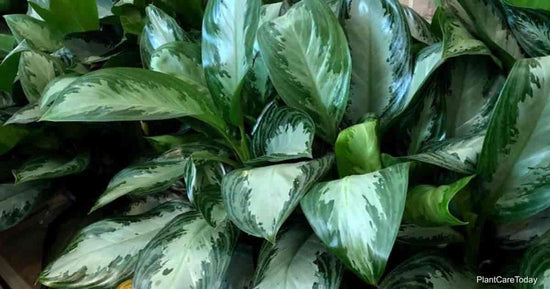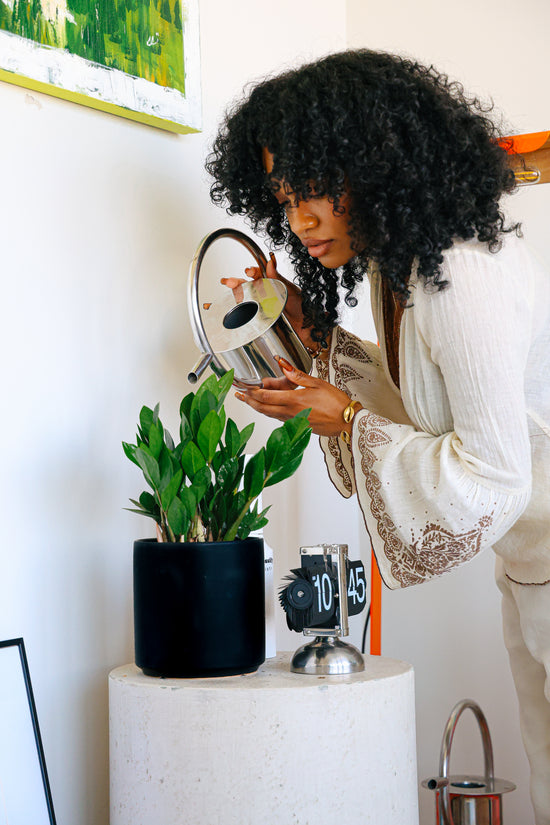Maintenance: Low | Climate: Warm + Humid | Light: Bright + Indirect | Watering: Consistent | Pet Safe: No
CHARACTERISTICS
Aglaonemas are a subtropical plant originating from areas of southeast Asia. These make beautiful tabletop plants, surely attracting admiration with their red and pink speckled leaves. A wonderful indoor companion, they grow to about three feet tall and last a lifetime under proper care. Thankfully, they are simple to care for and should flourish alongside you.
LIGHT
Aglaonemas prefer bright, indirect light. Placement at the interior of a room works just as but low light will result in stunted growth and dull leaves without red coloring. Avoid direct sunlight, which can burn and discolor the leaves.
WATER
Water this tropical plant generously once the soil is 50% dry, allowing excess water to flow out of the drainage hole. During fall and winter, you can gradually reduce the frequency, allowing the soil to get about 75% dry before watering. Non-tap water is recommended.
AIR
Keep indoor temperatures between 65º-85º to prevent stress and cosmetic damage. This plant does well in average indoor air but to keep it at its happiest, we recommend adding a boost humidity to the air.
Here are some easy ways to boost humidity:
- Add a humidifier nearby
- Create a pebble tray that lives underneath the pot
- Misting the leaves 3-5x per week with non-tap, lukewarm water
- Placement in a bathroom or kitchen (if lighting is suitable)
It should be kept away from drafts, vents, and drastic temperatures changes.
PLACEMENT
Aglaonemas are known as lucky plants that attract fortune and positive energy. Whether in the home or workplace, their growth motivates visions of prosperity while focusing on gratitude for the present. While ensuring its environmental needs are met, consider placing it intentionally in your home using this symbolism. These make great tabletop or plant-stand plants for the office, communal area, and bedroom.
POTTING & SOIL
We recommend a ceramic planter with a drainage hole to provide good moisture balance for this tropical plant. For healthy soil, seek a well-draining mix with amendments such as perlite, sand, vermiculite, and coco coir.
When repotting, keep it in a planter of the same size or no more than 2 inches larger. While you should refresh the soil every growing season for new nutrients, you can go 1-2 years without needing to pot it again.
SEASONAL CARE
This plant is pretty low-fuss and follows the same seasonal precautions as most other houseplants:
- Reduce the watering frequency during fall and winter while the plant rests and the soil dries slower.
- If they’re on a windowsill, they may need to be moved a few feet away to avoid cold drafts.
- Keep away from vents and radiators that push out heat.
- Be sure provide some extra humidity throughout the cold months as well.
At the start of Spring, gradually increase your watering frequency again and fertilize every 2-3 weeks. Do not fertilize for at least 6 weeks after it has been repotted.
PRUNING & PROPAGATION
You may find that you need to ocassionally prune your Aglaonema to keep it healthy and looking its best. This is usually only necessary to remove damaged leaves or leaves that are old and ready to go.
Always use clean scissors to cut the leaf or simply pinch it off with your fingers. If your plant has a fungus infestation, it's recommended to prune away the infected leaves.
How to Propagate Your Red Aglaonema:
Aglaonemas are easily propagated via cuttings in water. This simple method allows you to grow a new plant from the one you already have! After roots have grown, plant it in a new pot, the same pot, or share with a loved one.
- Use clean scissors or pruning shears
- Select a stem bunch that contains at least four or more healthy leaves
- Make an angled cut close to the soil level, where all the leaf stems meet at the base
- Place in a clean glass/jar of water, filled just enough to cover the stem (no leaves should be submerged)
- Keep the water clean and wait for roots to grow 2+ inches
- Pot in loose, well-draining soil and watch it grow!
Tip: If you're having a hard time caring for your struggling Aglaonema, propagate the healthiest sections so you can start over fresh. Read more on propagating here!
COMMON ISSUES
This plant should not give you too many issues but some concerns you may encounter are below:
BROWN LEAVES
Brown leaves on a Red Aglaonema are commonly a result of underwatering. Check the soil moisture with your finger or a moisture meter and water anytime the soil is 50% dry. Leaf tips and edges may also go brown if the air is very dry or if it is exposed to direct sunlight.
FADING LEAF COLOR
Aglaonemas rely on bright, indirect light to maintain their beautiful leaf pattern and color. Low light will cause the red spots to dull, showing a mostly green leaf. Leaves may also fade with age as old leaves die or due to a lack of proper nutrients.
YELLOW LEAVES
Yellow leaves are most commonly from overwatering. Soil only needs to be watered when it has dried 50%-75% down. Yellowing is also common for old leaves, in pots with poor drainage, or due to shock from a recent change.
LIMP LEAVES
Leaves will go limp in response to living in an improper environment or receiving improper care. Make sure its environmental needs are met (see "Air" above) and that it is watered consistently after the soil has dried at least 50% down. If your plant is repeatedly wilting, check for root rot, or pest, and fungus infestations, too.
-------
We love to see your new growth! Tag us at @groun.ded!





